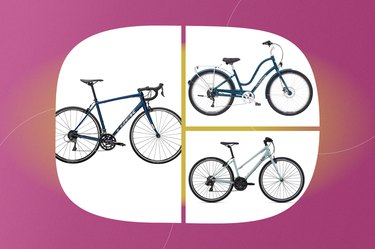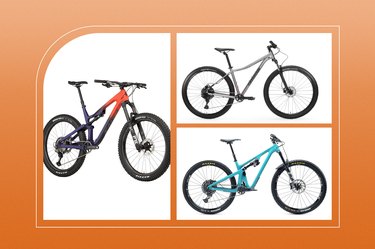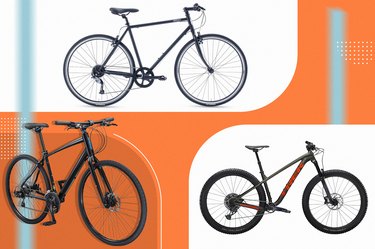
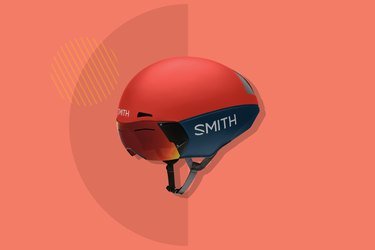
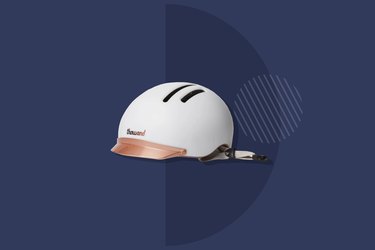
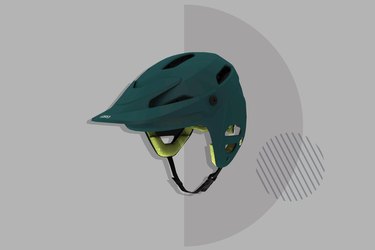
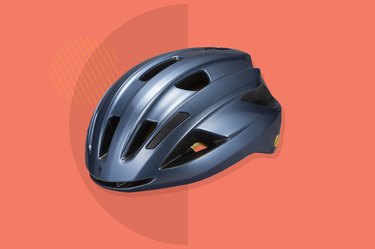
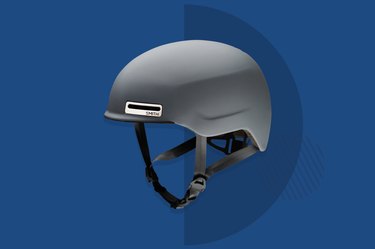
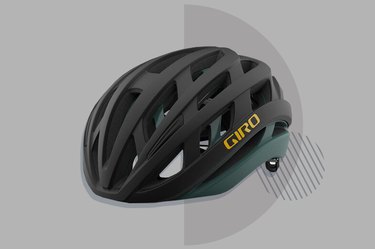
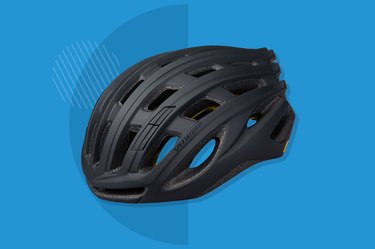
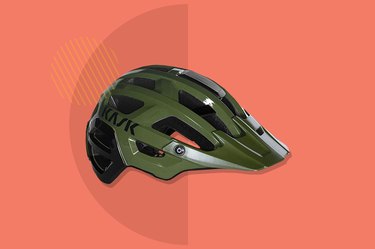
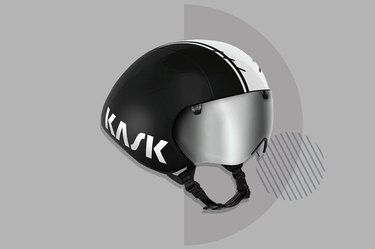
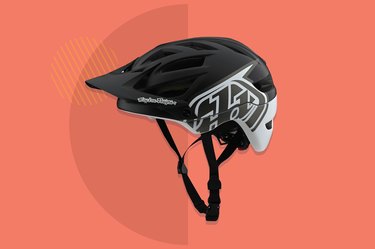
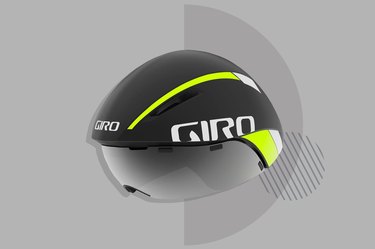
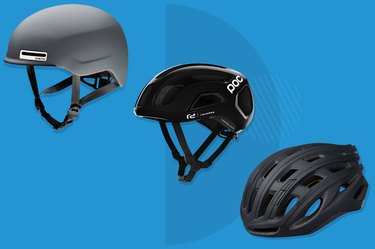
Choosing a bike helmet can be one of those things you might not think twice about, but it's important to not just pick up the first one you find.
As protective gear, your bike helmet needs to fit properly and have the appropriate safety features for the activity you're doing, whether it's mountain biking or cruising neighborhood streets.
Video of the Day
Video of the Day
"The right helmet will protect your head, which of course is the most important part," says John Cordoba, product manager at Specialized. "The wrong helmet could leave you unprotected, [at risk of] a concussion or something much worse."
How We Chose
With so many options on the market, how is someone supposed to settle on the perfect style? Below, experts share 12 of the best bike helmets for adults and weigh in on what you need to know before buying, based on the following criteria:
- Price
- Discipline
- Safety features
- Technology
- Comfort
Best for Commuting
For commuter bike helmets in particular, visibility is important as you'll be riding both before and after work — perhaps in low-light conditions.
And although you may find some products with added reflectors, which could be helpful, says Eddie Meek, customer experience manager at Priority Bicycles. He stresses that the most important feature for commuter cyclists is lights on the actual bike, to alert cars and fellow riders to your location.
1. Thousand Chapter MIPS Helmet
- Sizes: S, M, L
- Colors: 3
Buy it: Amazon.com; Price: $145
2. Specialized Align II
- Sizes: S/M, M/L, XL
- Colors: 11
Buy it: Specialized.com (From $27.45 to $55); CompetitiveCyclist.com ($54.99)
3. Smith Maze Bike Helmet
- Sizes: S, M, L
- Colors: 3
Buy it: SmithOptics.com Price: $80
Best for Road Cycling
Ventilation is something you really want to take into account when you start to pick up the cadence and pace, Meek says. "If you're hot, it's going to be uncomfortable, and if you're uncomfortable, you may be tempted to ditch your helmet, which is a big no," he adds.
Your head heats up just like the rest of you when you're pushing yourself during an outdoor cycling workout, so these helmets will have more ventilation and a sleeker look.
Some road bike helmets also feature SPIN (Shearing Pad INside) technology, which is a silicone, gel-like membrane inside the helmet padding that enhances ventilation and protection. They might also have grooves, where riders can securely stash sunglasses during shady miles.
1. POC Ventral Air Spin
- Sizes: S, M, L
- Colors: 6
Buy it: NA.POCsports.com ($175)
2. Giro Helios Spherical Helmet
- Sizes: S, M, L
- Colors: 7
Buy it: Giro.com (From $187.50 to $250); CompetitiveCyclist.com (From $149.95 to $249.95)
3. Specialized Propero III With ANGi
- Sizes: S, M, L
- Colors: 6
Buy it: Specialized.com ($130); CompetitiveCyclist.com ($149.99)
Best for Mountain Biking
When you're climbing hills, you have to be prepared, Meek says. That's why gravel and mountain bike helmets will have added protection in the back. You could fall in different ways than you might on a road bike. These styles will also have a visor in the front to protect against branches and other things that may get in your face, Meek says.
More intense riders who are leaning into downhill-specific training may opt for a style that resembles more of a BMX helmet. "Downhill helmets, as they're called, have full-face coverings," Meek says, adding that there are even some hybrid styles with a detachable face shield. "More serious and risky riding requires more protection." Very few recreational mountain bikers would need this next-level style, however.
1. Troy Lee Designs A1 With MIPS
- Sizes: XS, SM, MD/L, XL/2X
- Colors: 2
Buy it: TroyLeeDesigns.com; Price: $87
2. Giro Tyrant Spherical Helmet
- Sizes: S, M, L
- Colors: 9
Buy it: Giro.com (From $120 to $160); CompetitiveCyclist.com (From $94.95 to $169.95)
3. Kask Rex Mountain Bike Helmet
- Sizes: M, L
- Colors: 5
Buy it: CompetitiveCyclist.com; Price: $245
Best for Racing
This is likely a style cyclists and triathletes would only wear on race day or really serious training rides. The aerodynamic design reduces drag from wind to give you a competitive advantage. When trying them on, keep in mind that racing bike helmets are vented for performance, not necessarily comfort.
1. Giro Aerohead MIPS
- Sizes: S, M, L
- Colors: 5
Buy it: Giro.com (From $225 to $300); CompetitiveCyclist.com ($299.95)
2. Smith Jetstream TT MIPS
- Sizes: S, M, L
- Colors: 4
Buy it: SmithOptics.com; Price: $380
3. Kask Bambino Pro Helmet
- Sizes: M, L
- Colors: 5
Buy it: Amazon.com; Price: $420
4 Factors to Consider When Shopping for Your Best Bike Helmet
1. Safety
Every bike helmet on the market in the U.S. should be certified by the Consumer Product Safety Commission (CPSC). Getting certified requires passing specific tests to ensure that the biker is protected.
Double-check for this certification before making a purchase.
Above and beyond certification is the MIPS, or multi-impact protection system, a technology that's designed to absorb rotational impacts. Cycling statistics show that when a rider falls, they typically fall at an angle, according to MIPS Protection. MIPS is an added low-friction layer inside of a helmet that can reduce harmful forces transmitted to the brain during a collision.
Once you level up from a commute-friendly style to something that's intended for road, mountain or racing, you're likely going to want to choose an option that has this technology, Meek says. It is not required, however, and plenty of helmets that are CPSC-certified don't have MIPS.
2. Comfort
With any helmet, the most important things are comfort and safety. "If the helmet is more comfortable, you're more likely to wear it, which will make you more safe," Meek says.
3. Type
Just like you buy a certain sneaker for running versus lifting weights, the same goes for your helmet. There are different styles based on what you'll be wearing the helmet for, whether it's commuting, road cycling, mountain biking or competing.
Mountain bike helmets, for instance, offer full-face coverings for additional protection, while commuter helmets will emphasize comfort and visibility.
4. Size
The first thing you should consider when purchasing a bike helmet is what size will fit your head and head shape.
Typically, bike shops and online vendors will have helpful sizing guides to help you find the right fit. Just keep in mind that sizes will vary from brand to brand, which is why you should always take some measurements.
"The right size is critical," Meek says. "You can get a general sense of what size you want by measuring, but it's really ideal to try on the style you're into before purchasing, unless you're familiar with the way that a brand or particular model fits."
Meek says the right fit should be snug but not uncomfortable, and if the style is too loose, it might not offer the protection you need. You want the helmet to fit low on your forehead with only one to two fingers fitting between the bottom of your helmet and your eyebrows.
Ideally, you'll buy your helmet at a specialty retailer or direct from the outlet in-person, Cordoba adds. "This will help you nail the right fit and feel really comfortable with your decision."
How Often Should You Replace Your Bike Helmet?
There’s a general rule that you should replace your helmet every four to five years, Cordoba says.
"Although you may think it's cool, you definitely don’t want to wear a helmet from the '80s or '90s," he says, explaining that the quality of the foam degrades over time — especially in heat.
"If you’re in Arizona, for example, it would wear a lot faster than somewhere that is a cooler climate, like Washington State," he says.

